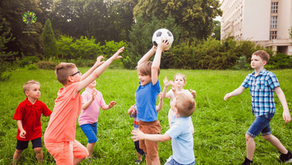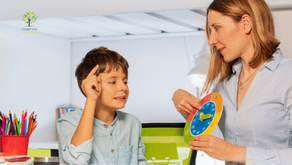Developing Fine Motor Skills in Children with Autism
- ChildFirst Behavior Therapy

- May 2, 2024
- 6 min read
Fine motor skills are essential for everyday tasks such as writing, grasping objects, and self-care activities like buttoning clothes or tying shoelaces. For children with autism spectrum disorder (ASD), developing these skills can be particularly challenging. However, with targeted interventions and support, children with autism can make significant progress in their fine motor abilities.
In this article, we'll explore the importance of fine motor skills for children with autism and provide practical strategies for parents and caregivers to help nurture these skills effectively. If you're considering ABA Therapy at home in Arlington Heights, IL, these strategies can complement your child's development and enhance their fine motor skills.
Understanding Fine Motor Skills in Children with Autism:

Children with autism often experience difficulties in processing, motor planning, coordination, and muscle strength, which can impact their fine motor development. Fine motor skills involve the coordination of small muscle movements in the hands and fingers, as well as hand-eye coordination. These skills are crucial for various tasks, including handwriting, using utensils, and engaging in play activities.
Common Challenges: Children with autism may exhibit a range of challenges related to fine motor skills, including:
Poor hand-eye coordination: Difficulty in coordinating visual information with hand movements.
Weak grasp: Inability to grasp objects with appropriate strength and precision.
Impaired dexterity: Difficulty in manipulating small objects or performing intricate movements.
Autism care: Autism issues, such as aversion to certain textures or sensations, can affect a child's willingness to engage in activities that promote fine motor development.
Importance of Developing Fine Motor Skills:
Enhancing fine motor skills in children with autism is crucial for several reasons:
Independence: Improved fine motor skills enable children to perform everyday tasks independently, enhancing their sense of autonomy and self-esteem.
Academic success: Proficient fine motor skills are essential for academic activities such as writing, drawing, and using classroom materials.
Social interaction: Fine motor activities often involve peer interaction, promoting socialization and communication skills in children with autism.
Emotional regulation: Engaging in fine motor activities can have a calming effect, helping children regulate their emotions and reduce anxiety levels.
Effective Strategies for Developing Fine Motor Skills:
Autism-based activities: Incorporate rich materials such as playdough, sand, or water into fine motor activities to engage multiple senses.
Hand strengthening exercises: Use simple exercises like squeezing a stress ball, playing with therapeutic putty, or using resistance bands to improve hand strength.
Occupational therapy: Seek guidance from occupational therapists who specialize in working with children with autism. They can provide individualized interventions to address specific fine motor challenges.
Visual supports: Use visual schedules, picture cards, or step-by-step instructions to help children with autism understand and follow tasks related to fine motor activities.
Break tasks into manageable steps: Teach complex skills by breaking them down into smaller, achievable steps, gradually increasing the level of difficulty as the child progresses.
Encourage self-care activities: Involve children in self-care routines such as buttoning shirts, brushing teeth, or using utensils during meals to promote independence and fine motor development.
Incorporate interests: Tailor fine motor activities to align with the child's interests and preferences, making learning more enjoyable and engaging.
Provide positive reinforcement: Praise and encourage efforts, even small achievements, to motivate children and boost their confidence.
Engage in play-based learning: Incorporate fine motor activities into playtime to make learning enjoyable and interactive. Activities such as building blocks, puzzles, and threading beads not only develop fine motor skills but also promote creativity and problem-solving abilities.
Model and scaffold: Demonstrate how to perform fine motor tasks and provide assistance as needed, gradually reducing support as the child gains confidence and proficiency. Modeling can help children with autism understand expectations and learn new skills more effectively.
Create a conducive environment: Ensure that the environment is organized and free from distractions to help children focus on fine motor activities. Minimize noise and clutter, and provide appropriate seating and workspace to support optimal engagement.
Foster a growth mindset: Encourage a positive attitude towards learning and growth by emphasizing effort and progress rather than focusing solely on outcomes. Help children understand that mistakes are opportunities for learning and improvement.
Collaborate with educators and therapists: Maintain open communication with teachers, therapists, and other professionals involved in the child's care to ensure a coordinated approach to addressing fine motor challenges. Share observations and strategies to support consistent progress across home and school settings.
Be patient and flexible: Recognize that progress may occur at different rates for each child and be patient during the learning process. Be flexible in adapting strategies and activities based on the child's individual needs and preferences.
Celebrate achievements: Acknowledge and celebrate the child's milestones and accomplishments in fine motor development. Whether it's mastering a new skill or demonstrating increased independence, every achievement deserves recognition and praise.
Encourage peer interaction: Provide opportunities for children with autism to engage in fine motor activities with peers, either in structured settings such as group therapy sessions or during social playdates. Peer interaction can enhance motivation, communication skills, and socialization while practicing fine motor tasks together.
Utilize assistive technology: Explore the use of assistive devices or technology to support fine motor development in children with autism. Specialized tools such as adapted utensils, styluses for touchscreen devices, or voice-activated software can help overcome physical barriers and facilitate participation in various activities.
Integrate gross motor activities: Incorporate gross motor activities such as dancing, jumping, or climbing into the child's routine to promote overall motor development. Strong gross motor skills provide a foundation for fine motor control and coordination.
Practice patience and persistence: Understand that building fine motor skills is a gradual process that requires ongoing practice and reinforcement. Be patient with the child's progress and continue to provide opportunities for skill-building in various contexts.
Seek support and resources: Connect with support groups, online forums, and community resources for parents of children with autism to exchange information, share experiences, and access valuable resources and strategies for enhancing fine motor skills.
Conclusion
In conclusion, developing fine motor skills in children with autism requires a multifaceted approach that encompasses autism-based activities, therapeutic interventions, and supportive strategies tailored to the individual child's needs. By implementing these strategies consistently and providing a nurturing environment that fosters growth and learning, parents and caregivers can help children with autism build essential fine motor skills and achieve greater independence and success in daily activities.
Together, we can empower children with autism to reach their full potential and thrive in all aspects of life.
Unlock your child's full potential with ChildFirst Behavior Therapy! Our team of compassionate experts is here to support your child's behavioral growth every step of the way. Led by Board Certified Behavior Analysts and Registered Behavior Technicians, we provide personalized care tailored to your child's unique needs.
Give your child the gift of success and schedule a consultation with us today. Together, let's empower your child's journey towards a brighter future with ABA Therapy! Visit us at ChildFirst Behavior Therapy to schedule a consultation.
FAQs
What are fine motor skills, and why are they important for children with autism?
Fine motor skills involve the coordination of small muscle movements in the hands and fingers, crucial for tasks like writing, using utensils, and self-care activities. For children with autism, these skills are particularly vital as they enhance independence, academic success, social interaction, and emotional regulation.
What are some common challenges children with autism face in developing fine motor skills?
Children with autism may experience difficulties such as poor hand-eye coordination, weak grasp, impaired dexterity, all of which can hinder their fine motor development.
How can parents and caregivers support the development of fine motor skills in children with autism?
There are various strategies, including autism-based activities, hand strengthening exercises, occupational therapy, visual supports, breaking tasks into manageable steps, encouraging self-care activities, incorporating interests, providing positive reinforcement, engaging in play-based learning, modeling and scaffolding, creating a conducive environment, fostering a growth mindset, collaborating with educators and therapists, being patient and flexible, celebrating achievements, encouraging peer interaction, utilizing assistive technology, integrating gross motor activities, practicing patience and persistence, and seeking support and resources.
How can autism-based activities help in developing fine motor skills in children with autism?
Autism-rich materials like playdough, sand, or water engage multiple senses, making fine motor activities more enjoyable and effective for children with autism.
What role does occupational therapy play in supporting fine motor development in children with autism?
Occupational therapists specializing in autism can provide individualized interventions to address specific fine motor challenges, offering strategies and exercises tailored to the child's needs and abilities.
How important is peer interaction in the development of fine motor skills for children with autism?
Peer interaction during fine motor activities promotes motivation, communication skills, and socialization while providing opportunities for practicing and learning new skills together in a supportive environment.
Are there any assistive technologies available to support fine motor development in children with autism?
Yes, there are various assistive devices and technologies like adapted utensils, styluses for touchscreen devices, and voice-activated software designed to overcome physical barriers and facilitate participation in fine motor activities.
How can parents and caregivers maintain patience and persistence during the process of developing fine motor skills in children with autism?
Understanding that progress may occur at different rates for each child and continuing to provide opportunities for practice and reinforcement are key. Patience, flexibility, and ongoing support are essential for navigating the gradual process of skill-building.
How can parents and caregivers identify the individual fine motor challenges their child with autism may face?
Understanding the specific fine motor difficulties their child encounters can help parents and caregivers tailor interventions and support strategies more effectively.
Are there any resources or support groups available for parents of children with autism seeking guidance on developing fine motor skills?
Accessing support groups, online forums, and community resources can provide valuable information, experiences, and strategies to assist parents in nurturing their child's fine motor development journey.







Comments